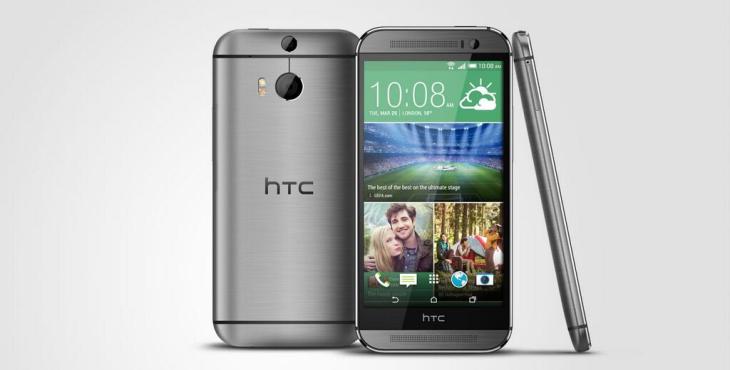HTC has revealed its HTC One (M8) smartphone, the gorgeous, if somewhat inelegantly named Android flagship and successor to last year’s original HTC One, the best-selling phone in HTC’s history. The device is debuting in ‘Gunmetal Gray,’ a finish we got a look at in a video leak yesterday, ‘Glacial Silver,’ and ‘Amber Gold,’ with a unibody all-metal design that appears, from a distance at least, to have every other Android smartphone currently available beat in terms of sheer good looks.
The new flagship ships with HTC’s new Sense 6 UI, and the company is highlighting its Duo Camera photo and video powers, as well as the new ‘Motion Launch’ gesture controls for enabling certain features on the phone without activating or even touching the screen. Another highlight for power users is the Extreme Power Saving Mode, which offers up to 14 days of standby operation by limiting features to only the essentials, like receiving incoming calls, texts and emails.
Basics
There’s a lot of new stuff unique to the HTC One (M8) in Sense 6, but first the basics: It’s an Android 4.4 KitKat smartphone packing a Qualcomm Snapdragon 801 2.3GHz quad core processor, has 2GB of RAM, and includes either 16GB or 32GB of onboard storage with up to 128GB expandable microSD card storage. LTE is supported, of course, and there’s Bluetooth 3.0, NFC, 802.11ac Wi-Fi (that’s rare for a smartphone) and an IR blaster. Sensors including the standard accelerometer, proximity sensor, ambient light sensor and gyro, as well as a barometer for detecting changes in air pressure immediately around you.
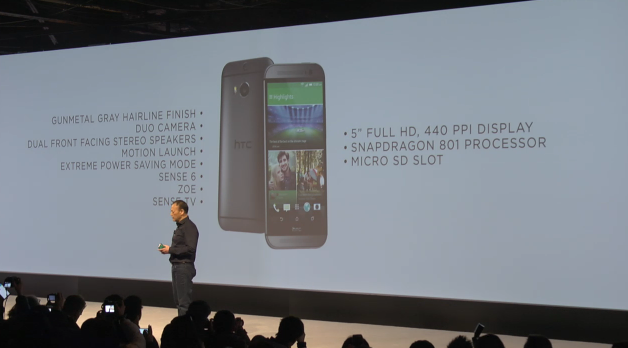
The battery has 2600 mAh capacity, and HTC says that’ll be good for up to 20 hours of 3G talk time, or up to 496 hours of standby on a 3G network connection, which is probably going to be roughly comparable to what the 2,800 mAh powerhouse on the slightly larger-screened Galaxy S5 will offer.
Camera
The display is a 5-inch, 1080 screen, and the primary rear camera has HTC’s UltraPixel module with 2.0 um pixels and a 1/3-inch sensor, shooting at f/2.0 with a 28mm lens. HTC isn’t even talking about megapixels on this bad boy, since they’ve made it very clear that they think that’s a discussion that isn’t worth having, and instead the focus should be on the size of pixels on the sensor and the quality of the photos.
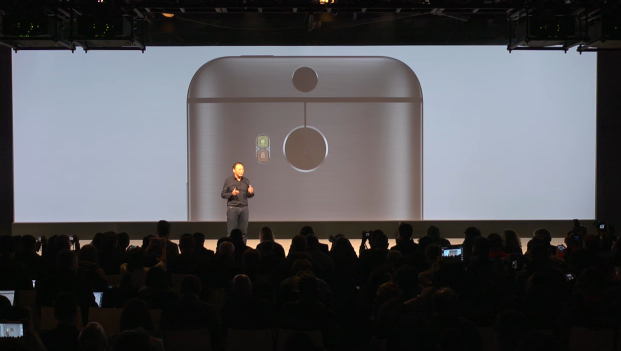
The rear camera has the new Duo Camera construction, with a dual flash, and full 1080p HD video recording. The Duo Camera manages to record a lot of information about depth related to scenes it captures, and that allows for advanced special effects. You can use ‘UFocus’ to change focus after the fact, like you can do with the Lytro Light Field camera, and you can also use Foregrounder to change out the background and apply creative effects. Seasons offers animated seasonal filters, and Copy & Paste (a forthcoming feature One owners will be able to get from Google Play soon) lets you swap family and friends out into entirely separate photos. Finally, you can alter your photo’s angle by tilting the screen with Dimension Plus. That’s also a recent Lytro feature, and probably will offer mostly minimal but nonetheless impressive angle shifting.
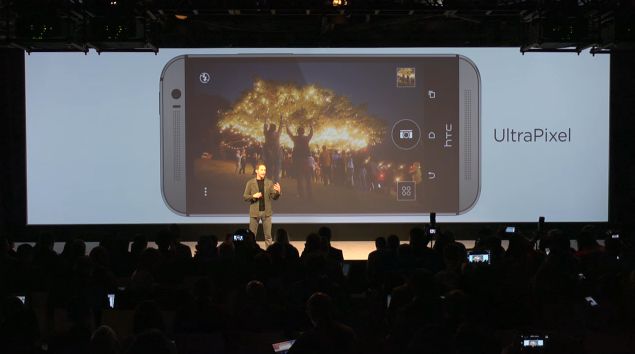
HTC also seems to be borrowing some camera tricks from Apple: its dual flash is designed to balance skin tones like the one on the iPhone 5s, and it also adds a Slow Motion mode for HD slo-mo video capture, also a feature of the 5s. There are also full manual controls for things like ISO and exposure, and you can save those settings as presets for future use. Finally, the front-facing camera has a 5 megapixel sensor for selfie-shots.
HTC is opening up its camera API to third-party devs, giving them full access to slow-mo and depth-sensing features, so they should come up with some interesting software that takes advantage of that rich photo data.
Gesture Control
The new HTC One offers gesture control, another popular feature among new smartphones. The M8 has what HTC is calling Motion Launch, which is a series of gesture controlled shortcuts to let you activate the screen, answer calls, and turn the lock screen on and off without swiping or tapping. It does this using low-power monitoring of orientation, speed, etc., with its onboard sensors to predict what you’ll want to do when you unlock the device.
Samsung has included some gesture controls in recent devices, but HTC’s use of the feature appears to be limited to just a few things that are targeted at everyday use case scenarios, rather than fanciful ideas of people waving at their device to interact with apps and services. Auto Answer, for instance, lets you raise the phone to your ear to accept a call, so that you don’t need to touch the screen if your hands are dirty or you’re otherwise reluctant to do so. This could also have an effect on battery life, by limiting the amount of active time for the power-hungry screen.
Throwback Case And Notifications
Another interesting part of the HTC One is its case – HTC has created a Dot View case that uses the above-mentioned Motion Launch gestures to provide essential information at a glance. The case displays key info like texts, emails, calls and weather notifications without activating the screen, and instead showing the info with a retro, dot-matrix style readout.
Paired with the metal finish, it’s a good look, and one that should help HTC stand out in the Android crowd.
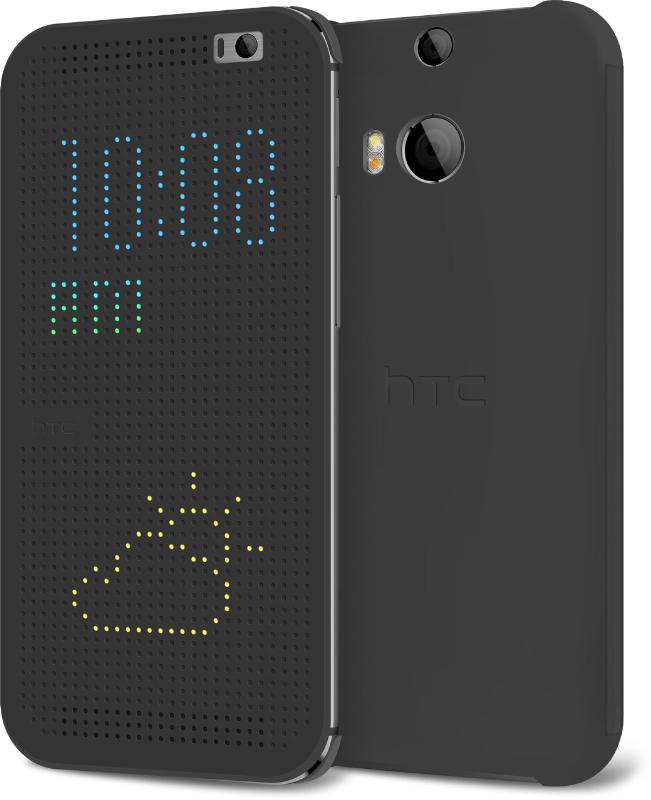
Juice When You Need It
Maybe one of the best features of the HTC One if it works as advertised is its new Extreme Power Saving Mode, arriving shortly after the device ships. The M8’s battery itself last 40 percent longer than usual already, and should offer 14 days of standby when used with a fully-charged phone. That’s like old-school BlackBerry numbers, and something generally unheard of with modern top-end Android devices.
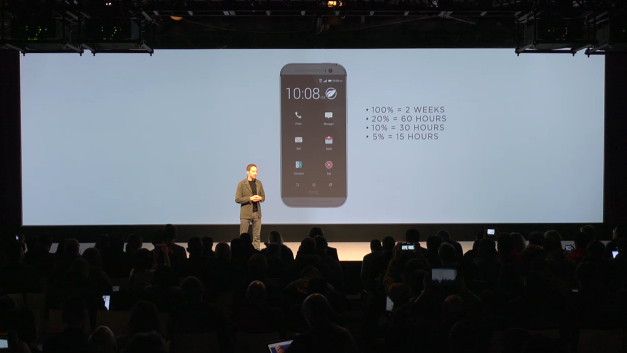
How does it do it? HTC seems to selectively disable services and keep things to core features like receiving calls and incoming texts – the bare minimum of what a phone is supposed to do. That means you’ll effectively be turning your smartphone into a feature phone with email, but it can be set to work automatically or manually, and offers 60 hours of additional standby at 20 percent battery remaining, 30 hours at 10 percent, and 15 hours at 5 percent, so if you’re caught in a tough spot, you won’t have to worry about making it through the weekend/day/night.
Samsung introduced a similar feature called ‘Ultra Power Saving Mode’ with its Galaxy S5 that seems to work in the same way, but Samsung itself claims 24 hours of additional runway at 10 percent, so theoretically at least, the HTC One (M8) has it beat.
Fitbit Preloaded
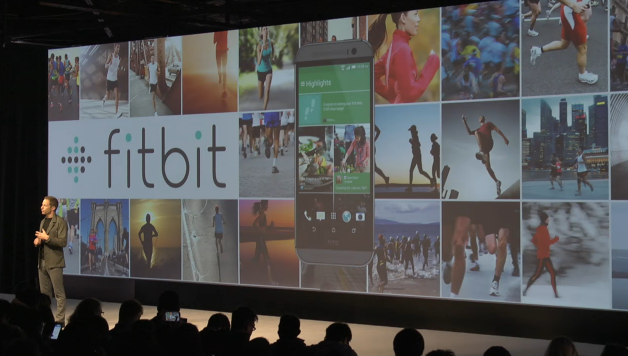
The Samsung Galaxy S5 offers a heart rate sensor and has a focus on health, but HTC has decided to go a different route: it’s offering the Fitbit app preloaded and feeding that data either from its built-in sensor suite or from Fitbit hardware.
Second Screen Play
HTC is embracing second-screen social trends with the M8, thanks to HTC Sense TV, which offers quick access to official FB and Twitter streams around TV shows, and live sports stats and updated for games from the world’s top 10 sports delivered as they happen.
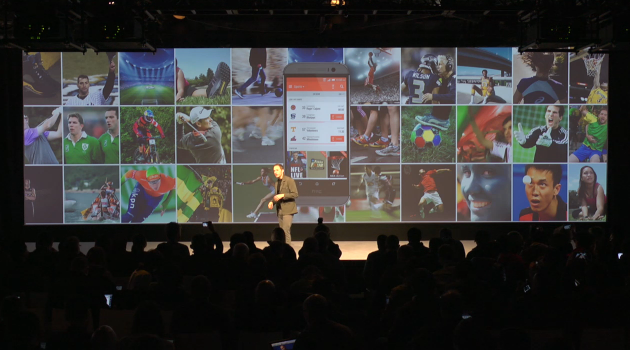
So far, software makers have been the ones primarily looking to capitalize on the increasing use of smartphones and tablets as second-screen sources of supplementary information for live programming, but seeing HTC build those features into its own spin on Android indicate some OEMs at least are realizing there’s value in trying to own that conversation with built-in tools.
All The Rest
HTC is adding a bunch more new stuff to the One, too, including BoomSound front-facing speakers it claims are improved, and a redesigned BlinkFeed that comes with a new SDK for partners to add in their own media content to the social news feed delivery system. Also, Zoe, the Vine-like HTC app or social sharing of short clips will be transitioning to a cloud-based service, HTC says, with an updated app hitting the Play Store later this summer.
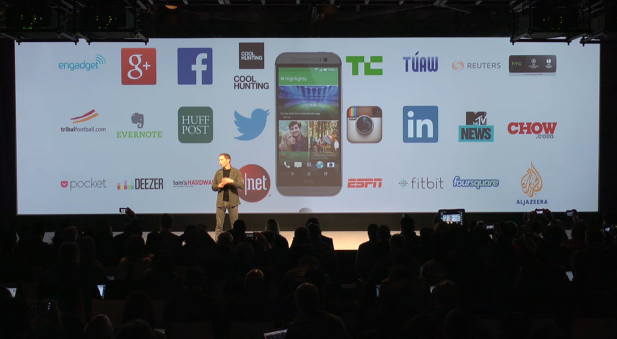
Before the end of April the HTC One will launch in Australia, UK, Taiwan, France, Canada and the US. Sense 6 will come to HTC One devices released in 2013 in April, too. HTC One (M8) will have broad in-store U.S. and Canadian availability in the first few weeks of April, and by April 10, but users can buy it online at 1PM ET today online direct from AT&T, Sprint, Verizon, Rogers, Bell and Telus in North America. Verizon will also have them in-store exclusively as of 1 PM ET today. Pricing in Canada is around $229 on a two-year agreement, or $700 outright, with American carriers offering it at around $649 without agreement or $199 with new two-year contracts. It’s also available in gold exclusively at Best Buy, where it can be purchased now for all major U.S. carriers.
The new HTC One seems like a solid improvement on the original, and that should be enough to make it a great phone, if not the best Android smartphone available. Releasing it the same day it’s announced is a bold move, and should help it win over some early adopters who were on the fence between this and the Samsung Galaxy S5, which comes out April 11 in the U.S., but only time will tell whether HTC hit the home run it needed with its latest device.
